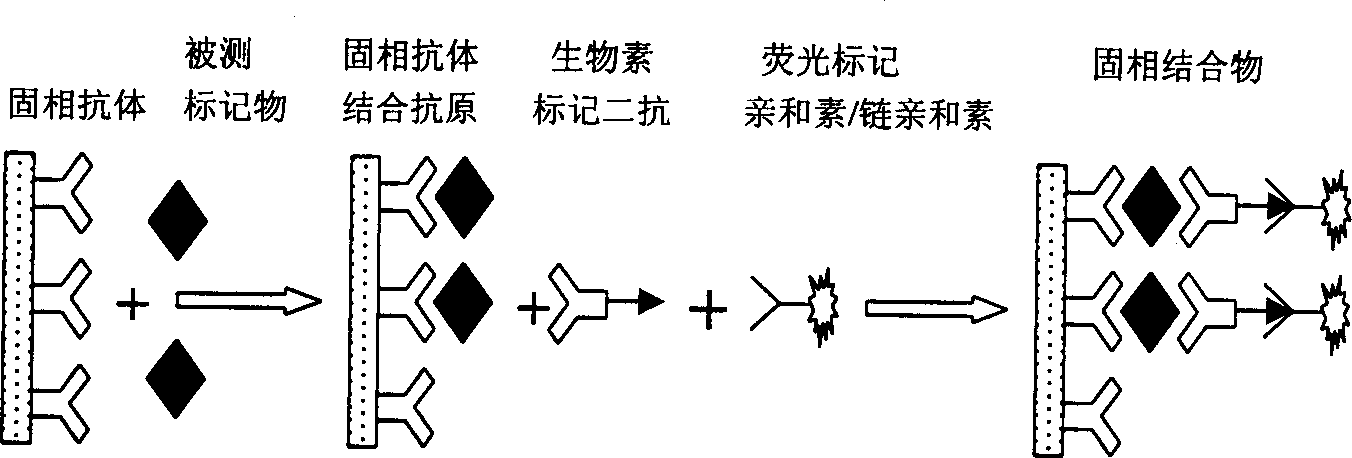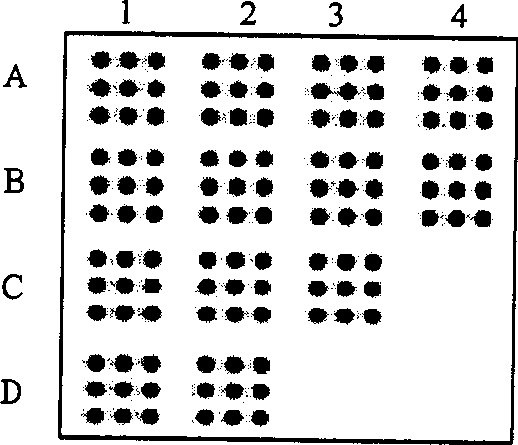Protein chip for diagnosing early malignant tumor
A technology of protein chips and malignant tumors, applied in the field of protein chips, can solve the problems of inability to detect malignant tumors, PCR false positives, complicated operations, etc., and achieve the effects of saving national financial resources, strong specificity, and good repeatability
- Summary
- Abstract
- Description
- Claims
- Application Information
AI Technical Summary
Problems solved by technology
Method used
Image
Examples
Embodiment 1
[0018] Specific implementation method embodiment one, such as image 3 A liver cancer diagnostic protein chip is shown, where A1: anti-alpha-fetoprotein (AFP) antibody A2: anti-γ-glutamyl transpeptidase isoenzyme (γ-GT) I', II, II' antibody A3: Anti-abnormal prothrombin (DPC) antibody A4: anti-α-L fucosidase antibody B1: anti-5'-nucleotide phosphodiesterase isoenzyme V, VI antibody B2: anti-placental glutathione S Transferase antibody B3: anti-α1-antichymotrypsin antibody B4: anti-ferritin antibody C1: anti-acid isoferritin antibody C2: anti-hepatitis B surface antigen antibody C3: hepatitis C antigen D1: positive control D2: negative control
[0019] So far, AFP is still the main experimental indicator for the diagnosis of liver cancer. However, in some benign liver diseases, teratomas of the reproductive system, and some malignant tumors of the gastrointestinal tract, AFP can also be elevated, while in other patients with hepatocellular carcinoma, AFP is always low...
Embodiment 2
[0021] Example two, such as Figure 4 As shown in the pancreatic cancer diagnostic chip,
[0022] A1: Anti-CA19-9 antibody
[0023] A2: Anti-CA242 antibody
[0024] A3: Anti-CA50 antibody
[0025] B1: Anti-CA72-4 antibody
[0026] B2: Anti-CA125 antibody
[0027] B3: Anti-tissue synthetic peptide antigen antibody
[0028] C1: Anti-carcinoembryonic antigen (CEA) antibody
[0029] C2: Anti-Peptide Carcinoma Peptide Antigen (POA) antibody
[0030] C3: Anti-galactosyltransferase isoenzyme II (GalTII) antibody
[0031] D1: Positive control
[0032] D2: Negative control
[0033] The same as the above-mentioned production method, the clinical detection type malignant tumor diagnostic protein chip for other organs can be designed.
Embodiment 3
[0034] Embodiment 3 The protein chip for the early diagnosis of general survey-type malignant tumors is formed by combining two or more known indicators of the clinical detection-type malignant tumor diagnosis protein chip.
PUM
 Login to View More
Login to View More Abstract
Description
Claims
Application Information
 Login to View More
Login to View More - R&D
- Intellectual Property
- Life Sciences
- Materials
- Tech Scout
- Unparalleled Data Quality
- Higher Quality Content
- 60% Fewer Hallucinations
Browse by: Latest US Patents, China's latest patents, Technical Efficacy Thesaurus, Application Domain, Technology Topic, Popular Technical Reports.
© 2025 PatSnap. All rights reserved.Legal|Privacy policy|Modern Slavery Act Transparency Statement|Sitemap|About US| Contact US: help@patsnap.com



